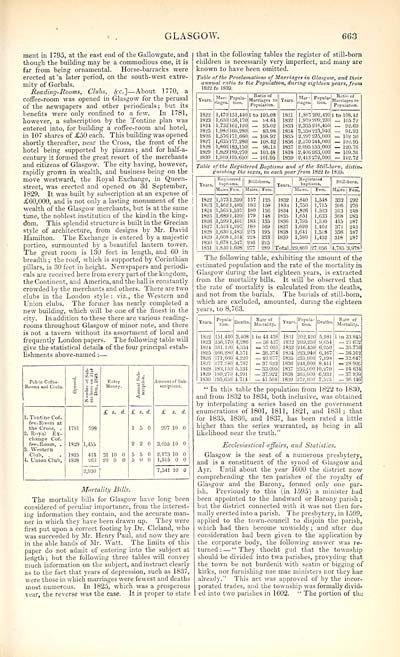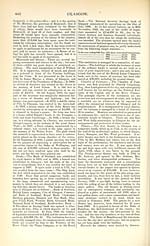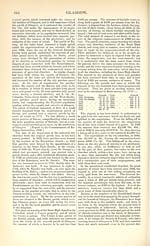Topographical, statistical, and historical gazetteer of Scotland > Volume 1
(761) Page 663
Download files
Complete book:
Individual page:
Thumbnail gallery: Grid view | List view

GLASGOW.
663
ment in 1 795, at the east end of the Gallowgate, and
though the building may be a commodious one, it is
far from being ornamental. Horse-barracks were
erected at 'a later- period, on the south-west extre-
mity of Gorbals.
Reading-Rooms, Clubs, Sfc.~\ — About 1770, a
coffee-room was opened in Glasgow for the perusal
of the newspapers and other periodicals ; but its
benefits were only confined to a few. In 1781,
however, a subscription by the Tontine plan was
entered into, for building a coffee-room and hotel,
in 107 shares of £50 each. This building was opened
shortly thereafter, near the Cross, the front of the
hotel being supported by piazzas ; and for half-a-
century it formed the great resort of the merchants
and citizens of Glasgow. The city having, however,
rapidly grown in wealth, and business being on the
move westward, the Royal Exchange, in Queen-
street, was erected and opened on 3d September,
1829. It was built by subscription at an expense of
£60,000, and is not only a lasting monument of the |
wealth of the Glasgow merchants, but is at the same
time, the noblest institution of the kind in the king-
dom. This splendid structure is built in the Grecian
style of architecture, from designs by Mr. David
Hamilton. The Exchange is entered by a majestic
portico, surmounted by a beautiful lantern tower.
The great room is 130 feet in length, and 60 in
breadth ; the roof, which is supported by Corinthian
pillars, is 30 feet in height. Newspapers and periodi-
cals are received here from every part of the kingdom,
the Continent, and America, and the hall is constantly
crowded by the merchants and others. There are two
clubs in the London style : viz., the Western and
Union clubs. The former has nearly completed a
new building, which will be one of the finest in the
city. In addition to these there are various reading-
rooms throughout Glasgow of minor note, and there
is not a tavern without its assortment of local and
frequently London papers. The following table mil
give the statistical details of the four principal estab-
lishments above-named : —
that in the following tables the register of still-born
children is necessarily very imperfect, and many are
known to have been omitted.
Table of the Proclamations of Marriages in Glasgow, and their
annual ratio to the Population, during eighteen years, from
1822 to 1839.
Ratio of
Tears. '■'"' ™pul»- Marriages to Years.
1S22
1823
1824
1825
1828
1827
1828
1829
|s:to
1,470
1,650
1.732
1,982
1,576
1,635
1,366
1 ,829
1,919
151,440
156,170
161,120
166,280
171,660
177.2S0
183,150
189,270
195,650
Population.
1 to 103.03
— 94.61
— 93.02
— 83.98
— 10S.92
— 108.42
— 9S.15
— 103.48
— 101.95
Mar- Popula- ,, Ra ?'° ° f
riages. lion. Marriages to
Population.
1S31
1S32
1333
1834
1835
1836
1837
1838
1839
1,867 202,420
1,979 209,230
2,335216,450
2,359 223,940
2,297235,000
2,370 244,000
2,095 253,000
2,406263,000
2,413 272,000
1 to 108.42
— 10572
— 92.69
— 94.93
— 102-30
— 102.95
— 120.76
— 109.31
— 112.72
Table of the Registered Baptisms and of the Still-born, distin-
guishing the sexes, in each year from 1822 to 1839.
-oS
«Sg
-5 c -
Public Coffee-
s
Entry
m .5
Amoiintof Sub-
Ruoms and Clubs.
5
a '■ ci
Money.
- E*
scriptions.
O
< "
£ s. d.
£ s. d.
£ s. d.
1. Tontine Cof-
fee-Room at
the Cross, .
1781
798
1 5
997 10
2. Royal Ex-
change Cof-
fee-Room, .
1829
1,455
2 2
3,055 10
3. Western
Club, .
1325
414
31 10
5 5
2,173 10
4. Union Club,
1338
263
20
5
1,315
2,930
7,541 10 j
Mortality Bills.
The mortality bills for Glasgow have long been
considered of peculiar importance, from the interest-
ing information they contain, and the accurate man-
ner in which they have been drawn up. They were
first put upon a correct footing by Dr. Cleland, who
was succeeded by Mr. Henry Paul, and now they are
in the able hands of Mr. Watt. The limits of this
paper do not admit of entering into the subject at
length ; but the following three tables will convey
much information on the subject, and instruct clearly
as to the fact that years of depression, such as 1837,
were those in which marriages were fewest and deaths
most numerous. In 1825, which was a prosperous
year, the reverse was the case. It is proper to state
Tears.
Registered
baptisms.
Still-born.
Tears.
Registered
baptisms.
Still-born.
Males [Fern.
Males. I Fem.
Mates.
Fem.
Males.
Fem.
1822
1823
1824
1825
1826
1827
1828
1829
13.1.
1831
l,573!l,399
1,462! 1,489
1,565'1,537
l,689'l,420
1,599 1,401
1,523 1,297
1,630 1,483
1,608 1,514
1,6781,547
1.S30 1,608
157
183
ISO
179
183
180
213
228
125
158
136
148
135
169
195
233
225
289
1S32
1833
1834
1835
1336
1837
1838
1839
Total,
1,S40
1,750
1,826
1,651
1,795
1,620
1,641
1,580
1,543
1,715
1,523
1,633
1,530
1,462
1,518
1,432
332
306
313
363
415
371
336
31S
292
276
248
283
287
245
247
287
277
29,860
27.056
4,735
3,978
The following table, exhibiting the amount of the
estimated population and the rate of the mortality in
Glasgow during the last eighteen years, is extracted
from the mortality bills. It will be observed that
the rate of mortality is calculated from the deaths,
and not from the burials. The burials of still-born,
which are excluded, amounted, during the eighteen
years,
to 8,'
63.
Tears.
Popula-
tion.
Deaths.
Rate of
Mortality.
Tears.
Popula-
tion.
Deaths.
Rate of
Mortality.
1322
151,440
3,403
1 in 44 436 ! : 18:11
202,420
5,981
1 in 33.845
1823
156,170 4,286
— 36 437B 1832
209.231]
9.654
— 21 672
1824
161.120 4,354
— 37.005
1833
216,450
6.050
— 35.776
1825
166,280 4,571
- 36.374
1834
223,940
6,167
— 36.312
1826
171,660 4,220
— 40.677
1835
235,000
7,193
— 32.647
1S27
177,230 4,7S7
- 37 033
1836
244,000
8.441
— 28.906
1823
183.150 5,534
— 33.095
1837
253,000
10,270
— 24 634
1829
189,270! 4,991
— 37.922
1833
263,000
6,932
— 37.939
1830 195,650 4.714
— 41.504'
18.19
272,000
7,525
— 36.146
" In this table the population from 1822 to 18.30,
and from 1832 to 1834, both inclusive, was obtained
by interpolating a series based on the government
enumerations of 1801, 1811, 1821, and 1831; that
for 1835, 1836, and 1837, has been rated a little
higher than the series warranted, as being in all
likelihood near the truth."
Ecclesiastical affairs, and Statistics.
Glasgow is the seat of a numerous presbytery,
and is a constituent of the synod of Glasgow and
Ayr. Until about the year 1600 the district now
comprehending the ten parishes of the royalty of
Glasgow and the Barony, formed only one par-
ish. Previously to this (in 1595) a minister had
been appointed to the landward or Barony parish ;
but the district connected with it was not then for-
mally erected into a parish. The presbytery, in 1599,
applied to the town-council to disjoin the parish,
which had then become unwieldy ; and after due
consideration had been given to the application by
the corporate body, the following answer was re-
turned : — " They thocht gud that the township
should be divided into twa parishes, provyding that
the town be not burdenit with seatin or bigging of
kirks, nor furnishing nae mae ministers nor they hae
already." This act was approved of by the incor-
porated trades, and the township w r as formally divid-
ed into two parishes in 1602. " The portion of tlifi
663
ment in 1 795, at the east end of the Gallowgate, and
though the building may be a commodious one, it is
far from being ornamental. Horse-barracks were
erected at 'a later- period, on the south-west extre-
mity of Gorbals.
Reading-Rooms, Clubs, Sfc.~\ — About 1770, a
coffee-room was opened in Glasgow for the perusal
of the newspapers and other periodicals ; but its
benefits were only confined to a few. In 1781,
however, a subscription by the Tontine plan was
entered into, for building a coffee-room and hotel,
in 107 shares of £50 each. This building was opened
shortly thereafter, near the Cross, the front of the
hotel being supported by piazzas ; and for half-a-
century it formed the great resort of the merchants
and citizens of Glasgow. The city having, however,
rapidly grown in wealth, and business being on the
move westward, the Royal Exchange, in Queen-
street, was erected and opened on 3d September,
1829. It was built by subscription at an expense of
£60,000, and is not only a lasting monument of the |
wealth of the Glasgow merchants, but is at the same
time, the noblest institution of the kind in the king-
dom. This splendid structure is built in the Grecian
style of architecture, from designs by Mr. David
Hamilton. The Exchange is entered by a majestic
portico, surmounted by a beautiful lantern tower.
The great room is 130 feet in length, and 60 in
breadth ; the roof, which is supported by Corinthian
pillars, is 30 feet in height. Newspapers and periodi-
cals are received here from every part of the kingdom,
the Continent, and America, and the hall is constantly
crowded by the merchants and others. There are two
clubs in the London style : viz., the Western and
Union clubs. The former has nearly completed a
new building, which will be one of the finest in the
city. In addition to these there are various reading-
rooms throughout Glasgow of minor note, and there
is not a tavern without its assortment of local and
frequently London papers. The following table mil
give the statistical details of the four principal estab-
lishments above-named : —
that in the following tables the register of still-born
children is necessarily very imperfect, and many are
known to have been omitted.
Table of the Proclamations of Marriages in Glasgow, and their
annual ratio to the Population, during eighteen years, from
1822 to 1839.
Ratio of
Tears. '■'"' ™pul»- Marriages to Years.
1S22
1823
1824
1825
1828
1827
1828
1829
|s:to
1,470
1,650
1.732
1,982
1,576
1,635
1,366
1 ,829
1,919
151,440
156,170
161,120
166,280
171,660
177.2S0
183,150
189,270
195,650
Population.
1 to 103.03
— 94.61
— 93.02
— 83.98
— 10S.92
— 108.42
— 9S.15
— 103.48
— 101.95
Mar- Popula- ,, Ra ?'° ° f
riages. lion. Marriages to
Population.
1S31
1S32
1333
1834
1835
1836
1837
1838
1839
1,867 202,420
1,979 209,230
2,335216,450
2,359 223,940
2,297235,000
2,370 244,000
2,095 253,000
2,406263,000
2,413 272,000
1 to 108.42
— 10572
— 92.69
— 94.93
— 102-30
— 102.95
— 120.76
— 109.31
— 112.72
Table of the Registered Baptisms and of the Still-born, distin-
guishing the sexes, in each year from 1822 to 1839.
-oS
«Sg
-5 c -
Public Coffee-
s
Entry
m .5
Amoiintof Sub-
Ruoms and Clubs.
5
a '■ ci
Money.
- E*
scriptions.
O
< "
£ s. d.
£ s. d.
£ s. d.
1. Tontine Cof-
fee-Room at
the Cross, .
1781
798
1 5
997 10
2. Royal Ex-
change Cof-
fee-Room, .
1829
1,455
2 2
3,055 10
3. Western
Club, .
1325
414
31 10
5 5
2,173 10
4. Union Club,
1338
263
20
5
1,315
2,930
7,541 10 j
Mortality Bills.
The mortality bills for Glasgow have long been
considered of peculiar importance, from the interest-
ing information they contain, and the accurate man-
ner in which they have been drawn up. They were
first put upon a correct footing by Dr. Cleland, who
was succeeded by Mr. Henry Paul, and now they are
in the able hands of Mr. Watt. The limits of this
paper do not admit of entering into the subject at
length ; but the following three tables will convey
much information on the subject, and instruct clearly
as to the fact that years of depression, such as 1837,
were those in which marriages were fewest and deaths
most numerous. In 1825, which was a prosperous
year, the reverse was the case. It is proper to state
Tears.
Registered
baptisms.
Still-born.
Tears.
Registered
baptisms.
Still-born.
Males [Fern.
Males. I Fem.
Mates.
Fem.
Males.
Fem.
1822
1823
1824
1825
1826
1827
1828
1829
13.1.
1831
l,573!l,399
1,462! 1,489
1,565'1,537
l,689'l,420
1,599 1,401
1,523 1,297
1,630 1,483
1,608 1,514
1,6781,547
1.S30 1,608
157
183
ISO
179
183
180
213
228
125
158
136
148
135
169
195
233
225
289
1S32
1833
1834
1835
1336
1837
1838
1839
Total,
1,S40
1,750
1,826
1,651
1,795
1,620
1,641
1,580
1,543
1,715
1,523
1,633
1,530
1,462
1,518
1,432
332
306
313
363
415
371
336
31S
292
276
248
283
287
245
247
287
277
29,860
27.056
4,735
3,978
The following table, exhibiting the amount of the
estimated population and the rate of the mortality in
Glasgow during the last eighteen years, is extracted
from the mortality bills. It will be observed that
the rate of mortality is calculated from the deaths,
and not from the burials. The burials of still-born,
which are excluded, amounted, during the eighteen
years,
to 8,'
63.
Tears.
Popula-
tion.
Deaths.
Rate of
Mortality.
Tears.
Popula-
tion.
Deaths.
Rate of
Mortality.
1322
151,440
3,403
1 in 44 436 ! : 18:11
202,420
5,981
1 in 33.845
1823
156,170 4,286
— 36 437B 1832
209.231]
9.654
— 21 672
1824
161.120 4,354
— 37.005
1833
216,450
6.050
— 35.776
1825
166,280 4,571
- 36.374
1834
223,940
6,167
— 36.312
1826
171,660 4,220
— 40.677
1835
235,000
7,193
— 32.647
1S27
177,230 4,7S7
- 37 033
1836
244,000
8.441
— 28.906
1823
183.150 5,534
— 33.095
1837
253,000
10,270
— 24 634
1829
189,270! 4,991
— 37.922
1833
263,000
6,932
— 37.939
1830 195,650 4.714
— 41.504'
18.19
272,000
7,525
— 36.146
" In this table the population from 1822 to 18.30,
and from 1832 to 1834, both inclusive, was obtained
by interpolating a series based on the government
enumerations of 1801, 1811, 1821, and 1831; that
for 1835, 1836, and 1837, has been rated a little
higher than the series warranted, as being in all
likelihood near the truth."
Ecclesiastical affairs, and Statistics.
Glasgow is the seat of a numerous presbytery,
and is a constituent of the synod of Glasgow and
Ayr. Until about the year 1600 the district now
comprehending the ten parishes of the royalty of
Glasgow and the Barony, formed only one par-
ish. Previously to this (in 1595) a minister had
been appointed to the landward or Barony parish ;
but the district connected with it was not then for-
mally erected into a parish. The presbytery, in 1599,
applied to the town-council to disjoin the parish,
which had then become unwieldy ; and after due
consideration had been given to the application by
the corporate body, the following answer was re-
turned : — " They thocht gud that the township
should be divided into twa parishes, provyding that
the town be not burdenit with seatin or bigging of
kirks, nor furnishing nae mae ministers nor they hae
already." This act was approved of by the incor-
porated trades, and the township w r as formally divid-
ed into two parishes in 1602. " The portion of tlifi
Set display mode to: Large image | Transcription
Images and transcriptions on this page, including medium image downloads, may be used under the Creative Commons Attribution 4.0 International Licence unless otherwise stated. ![]()
| Gazetteers of Scotland, 1803-1901 > Topographical, statistical, and historical gazetteer of Scotland > Volume 1 > (761) Page 663 |
|---|
| Permanent URL | https://digital.nls.uk/97446678 |
|---|
| Description | Volume first. A-H. |
|---|---|
| Attribution and copyright: |
|

